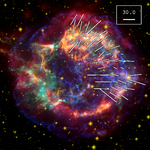Using ESO's Very Large Telescope, astronomers have gained new insights about the atmosphere of Pluto - (it's a dwarf now, get over it.)
What stands out? Large amounts of methane in the atmosphere and it's hotter than the surface by about 40 degrees, though -180 degrees Celsius is still not the place for your interplanetary tropical vacation. These properties of Pluto's atmosphere may be due to the presence of pure methane patches or of a methane-rich layer covering the dwarf planet's surface.
Artist’s love Pluto and one of them made this from one of the two models that a team of…
Space

Astronomy as a profession is hyper-specialized. What do you study-- planets, stars, galaxies, clusters, cosmology? Oh, if only it were that simple. Say you study stars. It doesn't stop there!
If stars, what wavelength? There's radio, IR, optical, UV, X-ray, gamma-ray, multi-wavelength work. Oh, you study X-ray emission from stars?
What kind of X-ray stars-- single, binaries, compact objects, remnants? You're into binaries?
What kind of binary star X-ray emission-- coronal, accretion disk, Roche lobe overflow?
By the time you pin yourself down as an expert…

I have read many works about black holes and one thing is possible to say for sure: nobody knows what really happens inside a black hole. There is a lot of theories about that. But they don’t have any scientific corroboration once nobody can see what happens in the center of the black hole, in a place called “gravitational singularity”, because even the light can escape from its incredible gravitational force.
However, we can use the imagination and the available knowledge in the field of atomic framing of matter, to create more verisimilar theory about the structure of the called “…

Interstellar space dust from a dead star identified by a research team led by The University of Nottingham could unlock some of the mysteries of the early universe.
Dr Loretta Dunne and her team have found new evidence of huge dust production in the Cassiopeia A supernova remnant, the remains of a star that exploded about 300 years ago. The paper is set to be published in the Monthly Notices of the Royal Astronomical Society.
Interstellar dust is found throughout the cosmos. It is responsible for the dark patches seen in the Milky Way on a moonless night. It consists of carbon and silicate…

A deep new image of the magnificent Helix planetary nebula has been obtained using the Wide Field Imager at ESO's La Silla Observatory. The image shows a rich background of distant galaxies, usually not seen in other images of this object.
The Helix Nebula, NGC 7293, lies about 700 light-years away in the constellation of Aquarius (the Water Bearer). It is one of the closest and most spectacular examples of a planetary nebula. These exotic objects have nothing to do with planets, but are the final blooming of Sun-like stars before their retirement as white dwarfs. Shells of gas are blown off…

Sadly, the Orbiting Carbon Observatory (OCO) had a launch failure, and is now spread out on Antarctica somewhere. Ironically, I'd written earlier today about the economics of the New Horizons mission.
For New Horizons, well, that launched successfully. OCO did not. This is a fundamental part of rocket science-- it either works or it doesn't. It either blows up or remains intact. When you're only launching one, the stakes are high. And rockets are risky.
The OCO satellite did everything it was supposed to do during launch-- namely, sit tight and not do anything. It was a rocket failure, but…

Sending stuff into space requires it be lightweight and functional. And people seem to really like their lightweight, functional iPhones. But if we just sent an iPhone to Pluto, it wouldn't be able to do stuff. It hasn't the range or survivability. On the other hand, using the DSN to transmit data to a New Horizons-sized PDA isn't feasible either. But why am I making these silly comparisons?
Dr. Henry Throop of SWRI started it. He made an interesting comparison of the iPhone versus the New Horizons mission to Pluto, as part of his PPT on "The New Horizons Geometry Visualizer: Planning the…
We're 54 days into the International Year of Astronomy, and what better way to celebrate than to peer at the heavens through your very own Galileoscope? Orders begin shipping in April.
Until your telescope arrives, grab a pair of binocs and check out the Green Comet. No, not a new summer blockbuster superhero franchise, but the comet Lulin. (I assume Bruce Willis and his team are standing by in case NASA calls.)
If you aren't doing anything after work on Friday, instead of going to happy hour take a boat down to the Southern Ocean off the southwestern coast of Chile. That is where the moon is…

On long, dark winter nights, the constellation of Orion the Hunter dominates the sky. Within the Hunter's sword, the Orion Nebula swaddles a cluster of newborn stars called the Trapezium. These stars are young but powerful, each one shining with the brilliance of 100,000 Suns. They are also massive, containing 15 to 30 times as much material as the Sun.
Where did the Trapezium stars come from? The question is not as simple as it seems. When it comes to the theory of how massive stars form, the devil is in the details.
We know the basics: a cloud of cosmic gas draws itself together, growing…

We hear a lot about 'going green' these days and it seems even the Universe can't endure one more moment of Al Gore putting his hands together, as if in prayer, and guilting us into investing in carbon trading companies, one of which he happens to own stock in.
As a peace offering, the cosmos is offering comet Lulin, which is making an appearance in the nighttime sky this month - and it's green. Literally. Don Yeomans of JPL, manager for NASA's Near-Earth Object Program Office, answers a few questions about this odd comet.
Sky chart showing comet Lulin on Feb. 24, 2009. Image credit:…
